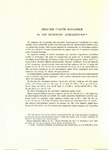| dc.description.abstract | ARCHAIC FIGURED POTTERY FROM
THE ANGELOPOULOS BUILDING SITE*
(Plates 2 9-3 7)
Rich was the harvest of bf. pottery in the excavation of the Angelopoulos building
site during the winter of 1961. The figured archaic pottery found is Attic
and covers all the sixth cent, as well as the first years of the fifth; it consists of fragments
only.
We present here forty fragments belonging to amphorae, Nos 1 - 7; oinochoai,
Nos 8-14 and 39; hydriai, Nos 15- 16; olpe, No 17; lekythos, No 18; lebes
gamikos, No 19; stands, Nos 20 -21; lids, Nos 25 - 26; cups, Nos 27 - 31; kraters,
Nos 32 a-e - 37; dinos, No 38; phiale, No 40.
The best preserved and most important pieces are:
Lebes gamikos (Nos 19 PI. 32g): flute player to the left and, under the preserved
handle, two heraldic lions; only the heads of all three are preserved. About
560 B.G. Krater (No 32 a- e PI. 35a-e), of which the lower part with the base of the
vase are preserved: A four men, B animals and bird. Middle of the sixth cent.
Oinochoe (No 9 PI. 31 g): part of a draped male figure, standing; quality
and character of the work recall the Amasis P.; surely it is by his own hand.
About 540 B. G.
Amphora (No 5a-d PI. 30), four fragments are preserved belonging to both
sides of the vase: A, B maenads and satyrs. About 540 B. C.
Lid ( No 26 PI. 33 b ), of which about half is preserved. Decoration: the hunting
of the Calydonian boar; part of the beast and three heroes are preserved —
the one, surely Angaios, lying under the belly of the boar. About 530 B.C.
Hydria (No 16 PI. 32 e ): fragment of the shoulder. Decoration: probably Amazonomachy;
on the preserved right end of the decorated area is an Amazon to
the left, throwing her spear against an enemy (not preserved). Last quarter of
the sixth cent. B.C.
Stand ( No 21 PI. 33 d ): lyre-player; the head of the man and part of the lyre
are preserved. Last quarter of the sixth cent. B. C.
Oinochoe (?) ( No 24 PI. 33 g ): Herakles and the Nemean lion; only the heads
and a small part of hands and paw survive. About 510 B. C.
Of special interest is the oinochoe No 39 ( P 1. 37a ) of which one side is preserved,
happily the decorated one: Dionysos to the left, holding a rhyton. The
decoration is in Six’s technique. The same technique has been used for the decoration
on a small fragment of a phiale ( No 40 PI. 37 b ) on which the head
of a horse to the right is preserved.
A comparative study of the two pieces has suggested to us that the material attributed
by Six to this technique should be divided into two groups:
Group A; including the incised vases of which the Sappho on the Goluchow Museum
hydria is the best known example. On these vases incision is richly used for
contour and details. The use of the colours red and white is the same as on the bf.
vases. The new find ( No 39 PI. 37 a ), dating in the decade 530 - 520 B. C., is
an excellent example of this group.
Group B; the really polychrome vases belong here; a great variety of colours—
brown, red, whitish, yellow — have been richly used for the whole of the decoration,
while incisions are very few (sometimes they do not exist at all). No 40
(PI. 37 b) dating in the first years of the fifth cent, belongs to this group.
The technique of group A was already used earlier on blazons of shields and
occasionally on vases represented on bf. vase paintings (Amasian fragment from
Samos, Beazley, Devel. PI. 26,1). Payne’s black-polychrome style (NC. p. 18-20
and No. 39; group of the Chigi vase) can be thought of as the remote antecedent
of the technique of group B. | en |



